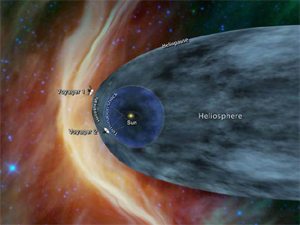



Date:08/10/18
 Voyager 2, the spacecraft, launched in 1977, is approaching the edge of the solar system, according to a NASA statement.
Voyager 2, the spacecraft, launched in 1977, is approaching the edge of the solar system, according to a NASA statement.
That announcement Friday is based on two different instruments on board, which in late August began noticing a small uptick in how many cosmic rays—superfast particles pummeling the solar system from outer space—were hitting the spacecraft.
That matches pretty well with what Voyager 1 began experiencing about three months before its own grand departure in 2012, but scientists cannot be sure of the milestone until after it has been passed, Space.com reported.
"We're seeing a change in the environment around Voyager 2, there's no doubt about that," Voyager Project Scientist Ed Stone, a physicist at Caltech, said in the statement.
"We're going to learn a lot in the coming months, but we still don't know when we'll reach the heliopause. We're not there yet—that's one thing I can say with confidence."
The team behind Voyager 2 knows that the spacecraft is currently almost 17.7 billion kilometers away from Earth. But it is hard to predict when the spacecraft will actually leave the solar system by passing through what scientists call the heliopause.
The heliopause is the bubble around our solar system formed by the solar wind, the rush of charged particles that constantly streams off the sun. But that solar wind ebbs and flows over the course of the sun's 11-year cycle, which means that the bubble of the solar system itself expands and contracts.
And because Voyager 2 is not following precisely in its predecessor's steps, scientists are not positive that its cosmic exit will result in identical changes to the data that the spacecraft reports. So until Voyager 2 passes through the heliopause, there is no way to be sure precisely where it is with regard to the heliopause.
Whenever it does successfully flee the solar system, Voyager 2 will become just the second human-made object to do so.
Voyager 2 leaving Solar System
 Voyager 2, the spacecraft, launched in 1977, is approaching the edge of the solar system, according to a NASA statement.
Voyager 2, the spacecraft, launched in 1977, is approaching the edge of the solar system, according to a NASA statement.That announcement Friday is based on two different instruments on board, which in late August began noticing a small uptick in how many cosmic rays—superfast particles pummeling the solar system from outer space—were hitting the spacecraft.
That matches pretty well with what Voyager 1 began experiencing about three months before its own grand departure in 2012, but scientists cannot be sure of the milestone until after it has been passed, Space.com reported.
"We're seeing a change in the environment around Voyager 2, there's no doubt about that," Voyager Project Scientist Ed Stone, a physicist at Caltech, said in the statement.
"We're going to learn a lot in the coming months, but we still don't know when we'll reach the heliopause. We're not there yet—that's one thing I can say with confidence."
The team behind Voyager 2 knows that the spacecraft is currently almost 17.7 billion kilometers away from Earth. But it is hard to predict when the spacecraft will actually leave the solar system by passing through what scientists call the heliopause.
The heliopause is the bubble around our solar system formed by the solar wind, the rush of charged particles that constantly streams off the sun. But that solar wind ebbs and flows over the course of the sun's 11-year cycle, which means that the bubble of the solar system itself expands and contracts.
And because Voyager 2 is not following precisely in its predecessor's steps, scientists are not positive that its cosmic exit will result in identical changes to the data that the spacecraft reports. So until Voyager 2 passes through the heliopause, there is no way to be sure precisely where it is with regard to the heliopause.
Whenever it does successfully flee the solar system, Voyager 2 will become just the second human-made object to do so.
Views: 454
©ictnews.az. All rights reserved.Similar news
- Azerbaijani project to monitor disease via mobile phones
- Innovative educational system to be improved under presidential decree
- NTRC prolongs license of two TV and radio organizations for 6 years
- Azerbaijan establishes e-registry for medicines
- Azerbaijani museum introduces e-guide
- Nar Mobile opens “Nar Dunyasi” sales and service center in Siyazan city
- International conference on custom electronic services held in Baku
- OIC secretary general to attend COMSTECH meeting in Baku
- Azerbaijan develops earthquake warning system
- New law to regulate transition to digital broadcasting in Azerbaijan
- Azerbaijani State Social Protection Fund introduces electronic digital signature
- Intellectual traffic management system in Baku to be commissioned in December
- Tax Ministry of Azerbaijan started receiving video-addresses
- World Bank recommends Azerbaijan to speed up e-service introduction in real estate
- Azerbaijan to shift to electronic registration of real estate





















